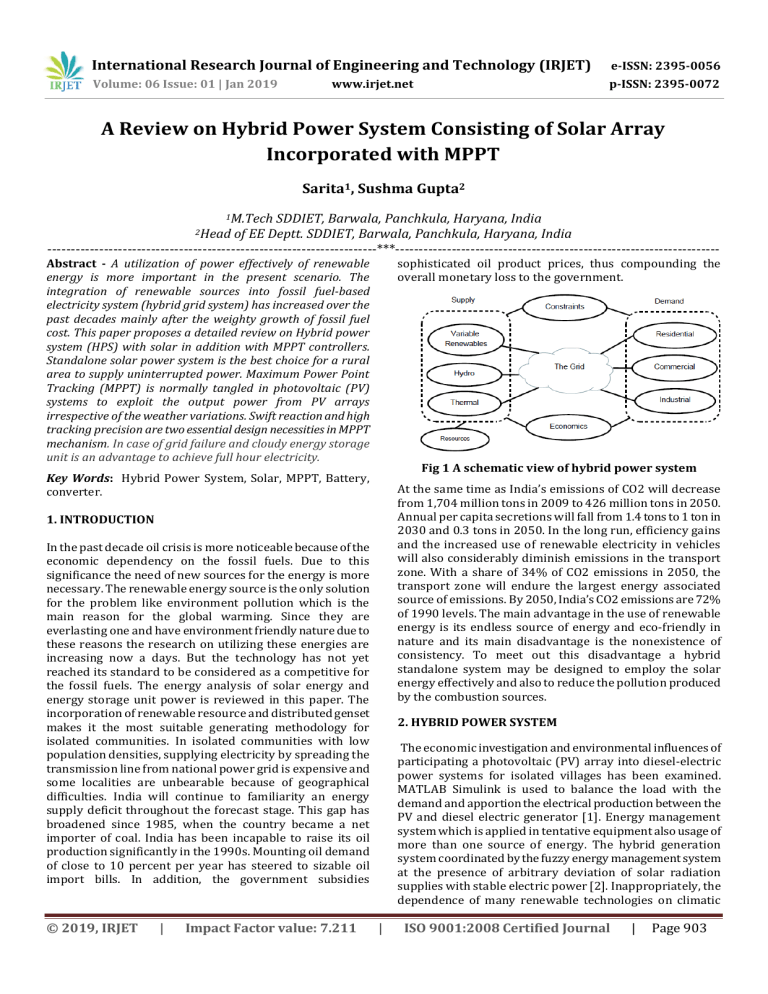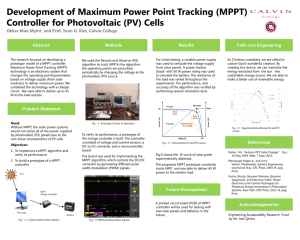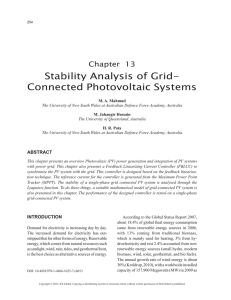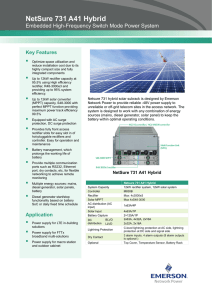IRJET-A Review on Hybrid Power System Consisting of Solar Array Incorporated with MPPT
advertisement

International Research Journal of Engineering and Technology (IRJET) e-ISSN: 2395-0056 Volume: 06 Issue: 01 | Jan 2019 p-ISSN: 2395-0072 www.irjet.net A Review on Hybrid Power System Consisting of Solar Array Incorporated with MPPT Sarita1, Sushma Gupta2 1M.Tech SDDIET, Barwala, Panchkula, Haryana, India of EE Deptt. SDDIET, Barwala, Panchkula, Haryana, India ----------------------------------------------------------------------***--------------------------------------------------------------------2Head Abstract - A utilization of power effectively of renewable energy is more important in the present scenario. The integration of renewable sources into fossil fuel-based electricity system (hybrid grid system) has increased over the past decades mainly after the weighty growth of fossil fuel cost. This paper proposes a detailed review on Hybrid power system (HPS) with solar in addition with MPPT controllers. Standalone solar power system is the best choice for a rural area to supply uninterrupted power. Maximum Power Point Tracking (MPPT) is normally tangled in photovoltaic (PV) systems to exploit the output power from PV arrays irrespective of the weather variations. Swift reaction and high tracking precision are two essential design necessities in MPPT mechanism. In case of grid failure and cloudy energy storage unit is an advantage to achieve full hour electricity. sophisticated oil product prices, thus compounding the overall monetary loss to the government. Fig 1 A schematic view of hybrid power system Key Words: Hybrid Power System, Solar, MPPT, Battery, converter. At the same time as India’s emissions of CO2 will decrease from 1,704 million tons in 2009 to 426 million tons in 2050. Annual per capita secretions will fall from 1.4 tons to 1 ton in 2030 and 0.3 tons in 2050. In the long run, efficiency gains and the increased use of renewable electricity in vehicles will also considerably diminish emissions in the transport zone. With a share of 34% of CO2 emissions in 2050, the transport zone will endure the largest energy associated source of emissions. By 2050, India’s CO2 emissions are 72% of 1990 levels. The main advantage in the use of renewable energy is its endless source of energy and eco-friendly in nature and its main disadvantage is the nonexistence of consistency. To meet out this disadvantage a hybrid standalone system may be designed to employ the solar energy effectively and also to reduce the pollution produced by the combustion sources. 1. INTRODUCTION In the past decade oil crisis is more noticeable because of the economic dependency on the fossil fuels. Due to this significance the need of new sources for the energy is more necessary. The renewable energy source is the only solution for the problem like environment pollution which is the main reason for the global warming. Since they are everlasting one and have environment friendly nature due to these reasons the research on utilizing these energies are increasing now a days. But the technology has not yet reached its standard to be considered as a competitive for the fossil fuels. The energy analysis of solar energy and energy storage unit power is reviewed in this paper. The incorporation of renewable resource and distributed genset makes it the most suitable generating methodology for isolated communities. In isolated communities with low population densities, supplying electricity by spreading the transmission line from national power grid is expensive and some localities are unbearable because of geographical difficulties. India will continue to familiarity an energy supply deficit throughout the forecast stage. This gap has broadened since 1985, when the country became a net importer of coal. India has been incapable to raise its oil production significantly in the 1990s. Mounting oil demand of close to 10 percent per year has steered to sizable oil import bills. In addition, the government subsidies © 2019, IRJET | Impact Factor value: 7.211 2. HYBRID POWER SYSTEM The economic investigation and environmental influences of participating a photovoltaic (PV) array into diesel-electric power systems for isolated villages has been examined. MATLAB Simulink is used to balance the load with the demand and apportion the electrical production between the PV and diesel electric generator [1]. Energy management system which is applied in tentative equipment also usage of more than one source of energy. The hybrid generation system coordinated by the fuzzy energy management system at the presence of arbitrary deviation of solar radiation supplies with stable electric power [2]. Inappropriately, the dependence of many renewable technologies on climatic | ISO 9001:2008 Certified Journal | Page 903 International Research Journal of Engineering and Technology (IRJET) e-ISSN: 2395-0056 Volume: 06 Issue: 01 | Jan 2019 p-ISSN: 2395-0072 www.irjet.net circumstances means that the changes forecasted may distress, unfavorably, their future feasibility. The Photovoltaic (PV) solar energy, a system which is comprehensively used as a vibrant intermittent energy resource. Hybrid systems composed of fuel cells and batteries can be merged with PV power systems to maintain uninterrupted power supply. In this paper, the hybrid power system is examined and control strategies for power management of the hybrid power system are evaluated. The planned hybrid power system is then established by simulation [3]. A system combining photovoltaic (PV) and fuel cell (FC) hybrid energy system for immobile applications. The system includes solar panels and a FC system working in parallel, an electrolysis system, power manager unit and storage tanks for the compressed hydrogen. The model is developed and performed on MATLAB/Simulink and also mathematical and electrical models developed for the projected system [4]. million dollars/yr (Previously it was 2.18 million dollars/yr). Carbon discharge is also very much abridged due to marginal usage of diesel [9]. Battery charge proficiency across a variety of input powers as an important performance parameter in flexible charging systems has been investigated. An correspondent circuit concept is used to model the fundamental trade-off between battery charging power and energy stored and it is compared with the existing Ragone model for discharge power and energy. An supplementary parameter is incorporated to account for undercharge and under discharge of the battery due to precipitate arrival at the battery’s voltage bounds. At a given power, energy efficiency is forecasted to be sophisticated for charging than discharging when only accounting for energy dissipated by internal resistance. The model is predictable to help to notify operational constraints for battery charging for flexible power sources [10]. A hybrid energy storage system (HESS) comprising of a battery bank and a super capacitor bank is used to smooth the inconsistent output power of the PV plant. The PV plant including the HESS has been modeled using MATLAB/Simulink and PLECS software environment [11]. The model performance and cost feasibility of a hybrid grid-tied micro grid has been discussed that makes use of the combination of solar photovoltaic (PV), batteries, and genset. The planned concept highlights that each community home is furnished with more solar PV than is required for normal operation [12] shown in fig 2. The modeling and simulation of a stand-alone photovoltaic (PV) plant with maximum power point tracking (MPPT) aspect and devoted battery storage. The overall plant contains of the PV module, battery bank, MPPT module, controller, inverter and a resistive load has been applied [5]. The load is delivered by both the PV and the battery reservoir. The model is built up using basic circuit equation of the photovoltaic (PV) solar cells comprising the effect of continuous solar irradiation and temperature. The experiment outcome shows the proposed methodology to the development of hybrid substitute energy system using MATLAB software to determine its possibility and performance [6]. Solar and wind energy are used as principal energy sources and battery unit is contemplated as storage to meet the primary load stress. A global power management approach is considered and applied for the planned system to accomplish power flows with the different energy sources, the storage unit and loads in the system. A simulation model for the hybrid energy system has been established using MATLAB/Simulink [7]. Among many renewable substitutes which have the potential to address these apprehensions, Photovoltaic Cells (PV) could be considered a reasonable solution. Photovoltaic Cells imprisonment solar radiation and convert it directly into electrical energy. A Shocktey Diode equation-based model was preferred to model solar arrays. A battery bank was modeled with parasitic model. The cost of generation of power by this method is higher than the conventional fossil fuel generation [8]. Fig 2 A hybrid power system connected with utility grid A few reports purposes to design and model a PV-Diesel power system for a generic remote town in Australia. The electricity generation philosophy using a centralized PV system along with the existing Diesel capacity is modelled and simulated in Hybrid Optimization of Multiple Energy Resources (HOMER) software. The study contemplates higher levels of PV penetration and conducts a technoeconomic investigation of dissimilar network structures to suggest a comprehensive electricity network design and generation philosophy, based on the cost of energy (AU$/kWh), the measure of surplus electricity, fuel savings potential and environmental impacts for a remote Australian town [13]. Optimum design of a grid associated hybrid A PV/Diesel Hybrid Power-Case Study, named as Zimbi is done for a Chromites mine factory by CRONIMET and it is located at 250 KM NW of Johannesburg, South Africa. The installed plant capacity is for 1 MW PV power among 1.6 MVA Diesel power at the cost of 2.66 million dollars for PV plant and the cost of saving is also examined. The accomplished diesel saving is around 450,000 lit/year, before installing PV power plant it was around 1.9 million lit/yr. The saving of running cost of Diesel is around 0.5 © 2019, IRJET | Impact Factor value: 7.211 | ISO 9001:2008 Certified Journal | Page 904 International Research Journal of Engineering and Technology (IRJET) e-ISSN: 2395-0056 Volume: 06 Issue: 01 | Jan 2019 p-ISSN: 2395-0072 www.irjet.net system, specially a grid connected PV diesel hybrid system, using a lot of definite Japanese customers’ yearly load curves. At last, the opportunity of the use of a grid connected PV-diesel hybrid system is exemplified [14]. A new method was proposed to conclude the placement and sizing of diesel generators (DGs), photovoltaic solar panels (PV) and batteries for off-grid systems. In this work, the aim is to reduce the total system cost while fulfilling the load demand and maintaining the grid power quality, among other controls [15]. One of the islands on Kepulauan Seribu in Jakarta province which is off-grid connected from electrical power systems that originates from Java main Island so that the electricity is moderately inadequate and it be contingent on diesel generators has studied. In accordance with the development of renewable energy sources technology, the use of PV System can be considered to support the existing diesel generator [16]. Smart energy management scheme for a microgrid, consisting of a diesel generator and power electronic converter interfaced renewable energy-based generators, such as photovoltaic (PV) and fuel cell, for frequency regulation without any storage [17]. The environmental and economic optimal operation of microgrid in grid-connected and island modes has been calculated. Considering the operation constrains of microgrid, the constrained multi-objective optimization problem (CMOP) is constructed with the fuel cost, devaluation disbursement and discharge cost of distributed generators as optimization objectives [18]. Photovoltaic (PV)-section can be amplified [21]. A novel multi objective control algorithm deliberated for impartial PV power systems that can trail out the maximum power point of the solar array while restrictive the charging/discharging current and voltage of the battery beneath different insolation and load circumstances [22]. Bearing in mind, the temperature and sun's irradiance, the PV array is modeled and its voltage current features and the power and voltage features are fabricated. This allows the dynamics of PV system to be simply simulated and optimized. It is detected that the output features of a PV array are influenced by the ecological issues and gives low renovation efficacy. As a result, a maximum power tracking (MPPT) technique is needed to trail the peak power to maximize the generated energy. The maximum power point in the power–voltage graph is familiar by an algorithm called perturbation & observation (P&O) method or Hill climbing. This algorithm will ascertain the appropriate duty ratio in which the DC to DC converter should be operated to amplify the power output [23]. The significance of MPPT accessible for effective maneuver and power withdrawal from a PV module. Among the numerous existing MPPT algorithms, the open voltage (OV) based algorithm is chosen to design the planned MPPT circuit developed in their paper [24]. A new fuzzy adaptive proportional-integral-derivative (PID) control strategy expounded with an online set-point tracing being described for maximum power point tracking (MPPT) in solar photovoltaic (PV) system. The range of the membership functions of the fuzzy logic for online PID constraint tuner has been optimized with the help of relay feedback tuning method. The recommended MPPT controller has been intended with online set-point adjustment method using current, radiation and temperature instruments [25]. A novel stepped-up anarchy optimization algorithm investigated for maximum power point trailing (MPPT) scheme in photovoltaic system to achieve the maximum efficacy. Moderately the projected procedure is sharper than conventional anarchy methods [26]. 3. REVIEW ON MPPT The Maximum power point tracking (MPPT) was employed in photovoltaic (PV) systems to amplify the photovoltaic array output power, regardless of the temperature and irradiation circumstances and of the load electrical topographies. An pioneering MPPT system has been developed, consisting of a Buck-type dc/dc converter, which is well-ordered by a microcontroller-based unit. The main difference between the method used in the planned MPPT system and other procedures used in the past is that the PV array output power is used to directly control the dc/dc converter, thus reducing the complication of the system [19]. A new MPPT controller investigated for a photovoltaic (PV) energy conversion system. Using the slope of power versus voltage of a PV array, the recommended MPPT controller permits the conversion system to pathway the maximum power point very swiftly. As contrasting to conventional two-stage designs, a single-stage configuration is executed, resulting in size and weight reduction and increased efficiency [20]. An advanced MPPT converter has been discussed with current compensation technique for smallscaled PV-applications. The envisioned technique smeared MPPT by variable reference current which is continuously mottled during one sampling period. Consequently, the proposed MPPT converter with current compensation method intensifications the power transmitted to the load above 9%. As a result, the utilization proficiency of © 2019, IRJET | Impact Factor value: 7.211 4. CONCLUSION This paper has provided a review of challenges and opportunities on integrating solar PV. An exertion has been made to extant acute and wide-ranging recover on this subject. Highlighting has been specified how to grab the power disputes in DG system. The main challenge for gridconnected system as well as the stand-alone system is the intermittent nature of solar PV. By integrating the two resources into an optimum combination, the impact of the variable nature of solar resources can be partially resolved and the overall system becomes more reliable and economical to run. Integration of renewable energy generation with battery storage and diesel generator backup systems is becoming a cost-effective solution for standalone type. It has been observed in this literature survey that most of the researchers have done work on hybrid power system problems confined to conventional power system. Further, it can be said that there exists a lot of research | ISO 9001:2008 Certified Journal | Page 905 International Research Journal of Engineering and Technology (IRJET) e-ISSN: 2395-0056 Volume: 06 Issue: 01 | Jan 2019 p-ISSN: 2395-0072 www.irjet.net opportunities in DG systems on issues related to hybrid system. Although PI controller is normally used for battery charging but fuzzy logic controller shows better performance. This survey paper will serve as a valuable reference for researchers to work on hybrid power system. 11) ACKNOWLEDGEMENT The work is financially supported by SDDGPI, Barwala, Haryana. I would like to thank my head of department Ms Sushma Gupta for providing me such environment. 12) REFERENCES 1) C.Thomas, M. Greenstone and C. R. Knittel, "Will we ever stop using fossil fuels?." Journal of Economic Perspectives 30.1 (2016): 117-38. 2) G. P. Harrison, and H. W. Whittington, “Investment in renewable energy: accounting for climate change.” In Power Engineering Society Summer Meeting, 2002 IEEE (Vol. 1, pp. 140-144). 3) S. Rohan, W. Tushar and K. Vijaykumar, “Indian energy scenarios: A review” Year: 2015 volume: 15 Pages: 785 – 790. 4) Li Wei, ‘Modeling, Control and Simulation of a Small Photovoltaic Fuel Cell Hybrid Generation System’, Proceedings of the International Conference on Computational Intelligence and Software Engineering, pp. 1-6,2009. 5) V. Eynde, NW, Chowdhury, S & Chowdhury, ‘Modeling and simulation of a stand-alone photovoltaic plant with MPPT feature and dedicated battery storage’, IEEE, Power and Energy Society General Meeting, pp. 1-8, 2010. 6) Raju, RGG, Vinothkumar, M, Kamalakannan, N & Subramaniam, NP 2011, ‘A hybrid alternative energy system with photovoltaic and fuel cell’, proceedings of the International Conference on Green Technology and Environmental Conservation, pp. 278-284. 7) Kumaravel, S & Ashok, ‘Adapted multilayer feed forward ANN based power management control of solar photovoltaic and wind integrated power system’, IEEE PES, Innovative Smart Grid Technologies - India, pp. 223-228, 2011. 8) Majumdar, S, Sapalok, A & Chakraborty, ‘Modeling components of a DC coupled photovoltaic system with maximum power point tracking’, Proceedings of IEEE 5th International Conference on power India, pp. 1-6,2012. 9) Moritz Hill & Rollie Armstrong, ‘ A PV/Diesel Hybrid Power-Case Study’ , Project “Zimbi” , CRONIMET Chrome South Africa (Pty.) Ltd., Johannesburg, South Africa, 2012. 10) Krieger, EM & Arnold, ‘Effects of undercharge and internal loss on the rate dependence of battery charge storage efficiency’, Journal of Power Sources, © 2019, IRJET | Impact Factor value: 7.211 13) 14) 15) 16) 17) 18) 19) 20) | 210 (2012), pp. 286– 291, 2012.Guishi Wang, Ciobotaru, M & Agelidis, ‘Power Smoothing of Large Solar PV Plant Using Hybrid Energy Storage’, IEEE Transactions on Sustainable Energy, vol. 5, no. 3, pp. 834-842, 2014. Patterson, M, Macia, NF & Kannan, AM 2015, ‘Hybrid Microgrid Model Based on Solar Photovoltaic Battery Fuel Cell System for Intermittent Load Applications’, IEEE Transactions, on Energy Conversion, vol. 30, no. 1, pp. 359366,2015. Taskin Jamal, Md. Asaduzzaman Shoeb, GM Shafiullah, Craig E Carter and Tania Urmee,’ A Design Consideration for Solar PV-Diesel Remote Electricity Network: Australia Perspective’ IEEE Innovative Smart Grid Technologies, 2016. Takahiro Kushida and Rikiya Abe,’ Optimal design of a grid connected PV-diesel hybrid system’, Environment and Electrical Engineering (EEEIC), 2016. Carlos at. el, ‘Development of a MicrocontrollerBased Photovoltaic Maximum Power Point Tracking Control System’, IEEE Transactions on Power Electronics, vol. 16, no. 1, pp. 46-54, 2001 H. Wicaksana, M. M. Muslim, S. F. Hutapea, A. Purwadi and Y. Haroen, ‘Design, Implementation and Techno-Economic Analysis of Hybrid PV-Diesel for Off-Grid System in Sebira Island’, IEEE Power Engineering and Renewable Energy,2016. P. C. Sekhar and S. Mishra, ‘Storage Free Smart Energy Management for Frequency Control in a Diesel-PV-Fuel Cell-Based Hybrid AC Microgrid’ IEEE Transactions on Neural Networks and Learning Systems, vol 27, pp 1657-1671, 2015. Tong Liu1, Qian Zhang1, Jinjin Ding1, Tao Rui and Qunjing Wang, ‘Grid-connected/Island Optimal Operation of PV-Diesel-Battery Microgrid with Plug-In Electric Vehicles’,IEEE Automation (YAC), 32nd Youth Academic Annual Conference of Chinese Association, 2017. Eftichios Koutroulis, Kostas Kalaitzakis & Nicholas C Voulgaris, ‘Development of a Microcontroller-Based Photovoltaic Maximum Power Point Tracking Control System’, IEEE Transactions on Power Electronics, vol. 16, no. 1, pp. 46-54,2001. Yeong-Chau Kuo, Tsorng-Juu Liang & Jiann-Fuh Chen, ‘Novel Maximum-Power-Point-Tracking Controller for Photovoltaic Energy Conversion System’, IEEE Transactions on Industrial Electronics, vol. 48, no. 3, pp.594-601, 2001. Dong-Yun Lee, Hyeong-Ju Noh, Dong-seok Hyun & Ick Choy , ‘An Improved MPPT Converter Using Current Compensation Method for Small Scaled PVApplications’, Proceedings of IEEE conference on Applied Power Electronics ,Vol. 1, pp. 540545,2003. ISO 9001:2008 Certified Journal | Page 906 International Research Journal of Engineering and Technology (IRJET) e-ISSN: 2395-0056 Volume: 06 Issue: 01 | Jan 2019 p-ISSN: 2395-0072 www.irjet.net 21) Zhenhua Jiang & Roger A Dougal, ‘Multiobjective MPPT/ Charging Controller for Standalone PV Power Systems under Different Insolation and Load Conditions’, IEEE, IAS 2004, pp.1154-1160, 2004. 22) Sridhar, R, Jeevananthan, S, Thamizh Selvan, N & Sujith Chowdary, ‘Performance Improvement of a Photo Voltaic Array Using MPPT (P&O) Technique’, IEEE,pp.191-195, 2010. 23) Ferdous, SM, Mahir Asif Mohammad, Farhan Nasrullah, Ahmed Mortuza Saleque & Shahriar Muttalib, ‘Design and Simulation of an Open Voltage Algorithm based Maximum Power Point Tracker for Battery Charging PV System’, 7th International IEEE Conference on Electrical and Computer Engineering, pp.908-911,2012. 24) Sandeepan Majumdar, Apoorva Sapalok & Niladri Chakraborty, ‘Modeling Components of a DC Coupled Photovoltaic System with Maximum Power Point Tracking’, Proc of IEEE conference on Power India, pp.1-6, 2012. 25) Karanjkar Dnyaneshwar, S, Chatterji, S, Amod Kumar & Shimi, ‘Fuzzy adaptive proportionalintegral-derivative controller with dynamic setpoint adjustment for maximum power point tracking in solar photovoltaic system’, Systems Science & Control Engineering: An Open Access Journal, vol. 2, no 1, pp. 562-582, 2014. 26) Lihua Wang, Xueye Wei, Yuqin Shao, Tianlong Zhu &, Junhong Zhang , ‘MPPT of PV array using stepped-up chaos optimization algorithm’, Turkish journal of Electrical Engineering and computer science, pp.1-13, 2015. © 2019, IRJET | Impact Factor value: 7.211 | ISO 9001:2008 Certified Journal | Page 907



